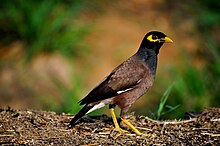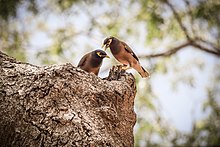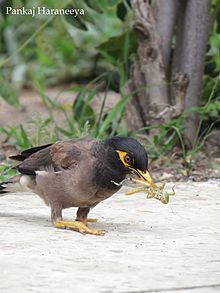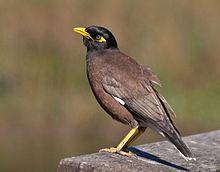One of the things I miss from when I lived in Hawaii on Maui and the Big Island are the sounds of the myna bird which are unmistakable. I have similar memories of "Mocking birds" when we moved to San Diego when I was 4 years old from Seattle as well. They are sort of loud but lend to the "jungle sounds" of Hawaii along with the constant crash of the waves in the distance which I have always loved about Hawaii. Their happy sounds are often what you wake up to every morning in Hawaii and their sounds you miss when you return to the Mainland after your visit to Paradise. Though Most people like to visit from December to March 15th I also like October to about April or May. After that, you better be young and healthy or adapted to this climate or be very careful when you first come and are adapting to it.
Common myna - Wikipedia
https://en.wikipedia.org/wiki/Common_myna
People also ask
Common myna - Wikipedia
https://en.wikipedia.org/wiki/Common_myna
Jump to Hawaii - In Hawaii, where the common myna was introduced to control pest armyworms and cutworms in sugarcane crops, the bird has helped to spread the robust Lantana camara weed across the islands' open grasslands.
Angry Birds Common Mynah - My Hawaii Nature Journal - Hawaii ...
hawaiinaturejournal.weebly.com/hawaii-plants-and.../angry-birds-common-mynah
Jul 22, 2013 - Acridotheres tristis tristis vs. Hawaii residents. Let's just say the common myna is not at the top of everyone's favorites list. This bird really gets ...
Problems With Myna Birds in Hawaii | Sciencing
https://sciencing.com › Nature
Apr 24, 2017 - Introduced to Hawaii from India in the 1860s, the myna bird has flourished on the islands. The birds build nests wherever there is space and ...
hawaiian mynah bird - YouTube
https://www.youtube.com/watch?v=AjP05mUpSoQ
Nov 16, 2011 - Uploaded by whaat808
Talking Pet Indian Mynah Asks Bird Vet Dr Ross Perry "What's Wrong?" 260810 - Duration: 9:24. Ross ...Native or Not? Hawaiian Birds Aren't Always What They Seem ...
https://abcbirds.org/native-or-not-hawaiian-birds/
Feb 25, 2016 - Mynas were introduced to Hawaii in 1866 to control cutworm moths, an agricultural pest. Native to India, the Himalayas, and the Middle East, the birds quickly spread throughout the main islands. No bird has been more vilified in Hawaii than the myna.
Morning talk with a mynah bird. [VIDEO] - Wimp.com
https://www.wimp.com/morning-talk-with-a-mynah-bird/
Kaleo, a talking mynah bird who was rescued in Hawaii when he was only three-Blog - Pest Mynah Birds in Hawaii - Sandwich Isle Pest Solutions
www.sandwichisle.com › Blog
Jul 29, 2016 - Mynah birds
with their vibrant yellow coloring are pretty to look at, but what they
do when they come onto your property is far from pretty.
Birds of PBRC -- About Mynahs
www5.pbrc.hawaii.edu/birds/mynahs.html
The mynah birds found in Hawaii are Common Mynahs (Acridotheres tristis tristis
A Few of Hawaii's Favorite Birds (26): Mimicking Maui's Mynas ...
https://kathrynwarmstrong.wordpress.com/.../a-few-of-hawaiis-favorite-birds-26-mimi...
Feb 12, 2015 - Myna Birds in Tree Of all the birds we saw in Hawaii, the most common were the myna birds. Breakfast on our Balcony They sang in the trees ...
Common Myna Added to “World's 100 Worst Invasive Species List”
blogs.thatpetplace.com/thatbirdblog/.../common-myna-added-to-worlds-100-worst-in...
Feb 3, 2011 - So it is sometimes surprising for bird fanciers to learn that at the ... The story of the Common Myna's “rise to power” on Hawaii is typical. Mynas ...
Searches related to hawaiian mynah bird
The
common myna/Indian mynah, sometimes spelled mynah, also sometimes known
as "Indian myna", is a member of the family Sturnidae native to Asia. Wikipedia
Scientific name: Acridotheres tristis
Length: 9.1 in. (Adult)
Clutch size: 4 – 6
Phylum: Chordata
Mass: Female: 4.2 – 4.9 oz (Adult), Male: 3.9 oz (Adult)
Did you know: The common myna is readily identified by the brown body, black hooded head and the bare yellow patch behind the eye. wikipedia.org
Common myna
| Common myna/Indian mynah | |
|---|---|
 |
|
| Acridotheres tristis in Kokrebellur, India | |
| Scientific classification | |
| Kingdom: | Animalia |
| Phylum: | Chordata |
| Class: | Aves |
| Order: | Passeriformes |
| Family: | Sturnidae |
| Genus: | Acridotheres |
| Species: | A. tristis |
| Binomial name | |
| Acridotheres tristis (Linnaeus, 1766) |
|
| Subspecies | |
|
Acridotheres tristis melanosternus Acridotheres tristis naumanni Acridotheres tristis tristis Acridotheres tristis tristoides |
|
 |
|
| Distribution of the common myna. Native distribution in blue, introduced in red. | |
The range of the common myna is increasing at such a rapid rate that in 2000 the IUCN Species Survival Commission declared it one of the world's most invasive species and one of only three birds in the top 100 species that pose an impact to biodiversity, agriculture and human interests.[3] In particular, the species poses a serious threat to the ecosystems of Australia where it was named "The Most Important Pest/Problem".[4]
Contents
Description
The common myna is readily identified by the brown body, black hooded head and the bare yellow patch behind the eye. The bill and legs are bright yellow. There is a white patch on the outer primaries and the wing lining on the underside is white. The sexes are similar and birds are usually seen in pairs.[5]The common myna obeys Gloger's rule in that the birds from northwest India tend to be paler than their darker counterparts in South India.[6][7]
Morphometry
Morphometry.[6]- Body length: 23 centimetres (9.1 in)
| Parameter/sex | Male | Female |
|---|---|---|
| Average weight (g) | 109.8 | 120-138 |
| Wing chord (mm) | 138-153 | 138-147 |
| Bill (mm) | 25-30 | 25-28 |
| Tarsus (mm) | 34-42 | 35-41 |
| Tail (mm) | 81-95 | 79-96 |
Distribution
It is a species of bird native to Asia with its initial home range spanning from Iran, Pakistan, India, Nepal, Bhutan, Bangladesh and Sri Lanka; as well as Afghanistan, Uzbekistan, Tajikistan, Turkmenistan, Myanmar, to Malaysia, Singapore, peninsular Thailand, Indo-China and China.[6][8]The myna has been introduced in many other parts of the world such as Canada, Australia, Israel, New Zealand, New Caledonia, Hawaii, South Africa, Kazakhstan, Kyrgyzstan, Florida,[9] Uzbekistan and islands in the Indian Ocean (Seychelles, Mauritius, Réunion, Madagascar, Maldives, Andaman and Nicobar Islands and Lakshadweep archipelago) and also in islands of the Atlantic, such as Ascension and St Helena, and Pacific Oceans.[6] The range of the common myna is increasing to the extent that in 2000 the IUCN Species Survival Commission declared it among the World's 100 worst invasive species.[3]
Etymology
The etymology of the scientific name is as follows:[10]- Acridotheres: Greek akris, akrodos, a locust; theres, a hunter.
- tristis: Latin tristis, sad, gloomy; Modern Latin tristis, dull-coloured).
Taxonomy and subspecies
The common myna has two subspecies:[6]- Acridotheres tristis tristis (Linnaeus, 1758). Widespread, including Sri Lanka.
- A. t. melanosternus Legge, 1879. Endemic to Sri Lanka.
Behaviour
Vocalisation
Calls
Common Myna In Guntur
Turquoise blue-coloured egg of common myna.
Breeding
Common myna evicting a nest of jungle babbler. Breaking the eggs of jungle babbler.
The normal clutch size is 4–6 eggs. The average size of the egg is 30.8 x 21.99 mm. The incubation period is 17 to 18 days and fledging period is 22 to 24 days.[6] The Asian koel is sometimes brood parasitic on this species.[13] Nesting material used by mynas include twigs, roots, tow and rubbish. Mynas have been known to use tissue paper, tin foil and sloughed off snake-skin.[6]
During the breeding season, the daytime activity-time budget of common myna in Pune in April to June 1978 has been recorded to comprise the following: nesting activity (42%), scanning the environment (28%), locomotion (12%), feeding (4%), vocalisation (7%) and preening-related activities, interactions and other activities (7%).[14]
The common myna uses the nests of woodpeckers, parakeets, etc. and easily takes to nest boxes; it has been recorded evicting the chicks of previously nesting pairs by holding them in the beak and later sometimes not even using the emptied nest boxes. This aggressive behaviour contributes to its success as an invasive species.[15]
Food and feeding
Common Myna prey on a grasshopper.
Roosting behaviour
Common mynas roost communally throughout the year, either in pure or mixed flocks with jungle mynas, rosy starlings, house crows, jungle crows, cattle egrets and rose-ringed parakeets and other birds. The roost population can range from less than one hundred to thousands.[17][18] The time of arrival of mynas at the roost starts before and ends just after sunset. The mynas depart before sunrise. The time and timespan of arrival and departure, time taken for final settlement at the roost, duration of communal sleep, flock size and population vary seasonally.[12][19][20]The function of communal roosting is to synchronise various social activities, avoid predators, exchange information about food sources.[21]
Communal displays (pre-roosting and post-roosting) consist of aerial maneuvers which are exhibited in the pre-breeding season (November to March). It is assumed that this behaviour is related to pair formation.[22]
Habitat
This abundant passerine is typically found in open woodland, cultivation and around habitation. Although this is an adaptable species, its population has been decreasing significantly in Singapore and Malaysia (where it is locally called as gembala kerbau, literally 'buffalo shepherd') due to competition with its cousin, the introduced Javan myna.[23]Urban success
The common myna thrives in urban and suburban environments; in Canberra, for instance, 110 common mynas were released between 1968 and 1971. By 1991, common myna population density in Canberra averaged 15 birds per square kilometer.[24] Only three years later, a second study found an average population density of 75 birds per square kilometer in the same area.[25]The bird likely owes its success in the urban and suburban settings of Sydney and Canberra to its evolutionary origins; having evolved in the open woodlands of India, the common myna is pre-adapted to habitats with tall vertical structures and little to no vegetative ground cover,[26] features characteristic of city streets and urban nature preserves.
The common myna (along with European starlings, house sparrows, and feral rock pigeons) is a nuisance to city buildings; its nests block gutters and drainpipes, causing water damage to building exteriors.[27]
Invasive species
The IUCN declared this myna as one of only three birds among the world's 100 worst invasive species[3] (the other two birds being the red-vented bulbul and the European starling.) It has been introduced widely elsewhere, including adjacent areas in Southeast Asia, Madagascar,[28] the Middle East, South Africa, Madagascar, Israel, the United States, Argentina, Germany, the United Kingdom, Australia, New Zealand and various oceanic islands in the Indian and Pacific Oceans, including prominent populations in Fiji and Hawaii.[8][29]The common myna is a pest in South Africa, North America, the Middle East, Australia, New Zealand and many Pacific islands. It is particularly problematic in Australia. Several methods have been tried to control the bird's numbers and protect native species.
Australia
In Sydney, Australia
The common myna was first introduced to Australia in Victoria between 1863 and 1872 into Melbourne’s market gardens to control insects. The bird is likely to have spread to New South Wales (where it is currently most populous) at around the same time, but documentation is uncertain.[30] The bird was later introduced to Queensland as a predator of grasshoppers and cane beetles. Currently, common myna populations in Australia are concentrated along the eastern coast around Sydney and its surrounding suburbs, with sparser populations in Victoria and a few isolated communities in Queensland.[31] During 2009 several municipal councils in New South Wales began trials of catching myna birds in an effort to reduce numbers.[32]
The bird can live and breed in a wide range of temperatures, ranging from the harsh winters of Canberra to the tropical climate of Cairns. Self-sustaining populations of common myna have been found in regions of mean warmest month temperature no less than 23.2 °C and mean coldest month temperature no less than -0.4 °C, implying that the common myna could potentially spread from Sydney northward along the eastern coast to Cairns and westward along the southern coast to Adelaide (though not to Tasmania, Darwin, or the arid interior regions).[33]
New Zealand
The Indian myna was introduced to both the North Island and South Island of New Zealand in the 1870s. However, the cooler summer temperatures in the South Island appear to have impeded the breeding success rate of the southern populations, preventing the proliferation of the species, which was largely non-existent there by the 1890s. In contrast, the North Island population was able to breed more successfully and large portions of the North Island are now populated. However, in the southern reaches of the North Island, the cooler summer temperatures, like those of the South Island, have prevented the establishment of large Indian myna populations.[34]South Africa
In South Africa where it escaped into the wild in 1902, it has become very common and its distribution is greater where human populations are greater or where there is more human disturbance.[35] The bird is also notorious for being a pest, kicking other birds out of their nests and killing their young due to the myna's strong territorial instinct. In South Africa it is considered somewhat of a major pest and disturbance of the natural habitat; as a result, they are frequently shot and killed by people in urban environments and farmers alike. Bylaws in South Africa pertaining to the protection of most animal species specifically exclude mynas from this protection.[citation needed]Morphological studies show that the process of spatial sorting is at work on the range expansion of A. tristis in South Africa.[36] Dispersal-relevant traits are significantly correlated with distance from the range core, with strong sexual dimorphism, indicative of sex-biased dispersal. Morphological variations are significant in wing and head traits of females, suggesting females as the primary dispersing sex. In contrast, traits not related to dispersal such as those associated with foraging show no signs of spatial sorting but are significantly affected by environmental variables such as vegetation and intensity of urbanisation.
Hawaii
In Hawaii it is out competing a lot of the native birds for food and nesting area.To study the invasion genetics and landscape-scale dynamics of A. tristis, scientists have recently developed 16 polymorphic nuclear microsatellite markers [37] using the next generation sequencing (NGS) approach.
Effect on ecosystems and humans
Threat to native birds
The common myna is a hollow-nesting species; that is, it nests and breeds in protected hollows found either naturally in trees or artificially on buildings (for example, recessed windowsills or low eaves).[38] Compared to native hollow-nesting species, the common myna is extremely aggressive, and breeding males will actively defend areas ranging up to 0.83 hectares in size (though males in densely populated urban settings tend to only defend the area immediately surrounding their nests).[39]This aggressiveness has enabled the common myna to displace many breeding pairs of native hollow-nesters, thereby reducing their reproductive success. In Australia, their aggressiveness has enabled them to chase native birds as large as galahs out of their nests.
The common myna is also known to maintain up to two roosts simultaneously; a temporary summer roost close to a breeding site (where the entire local male community sleeps during the summer, the period of highest aggression), and a permanent all-year roost where the female broods and incubates overnight. Both male and female common mynas will fiercely protect both roosts at all times, leading to further exclusion of native birds.[39]
Threat to crops and pasture
The common myna (which feeds mostly on ground-dwelling insects, tropical fruits such as grapes, plums and some berries and, in urban areas, discarded human food)[40] poses a serious threat to Australian blueberry crops, though its main threat is to native bird species.[41]In Hawaii, where the common myna was introduced to control pest armyworms and cutworms in sugarcane crops, the bird has helped to spread the robust Lantana camara weed across the islands’ open grasslands.[42] It also has been recorded as the fourth-ranking avian pest in the fruit industry by a 2004 survey of the Hawaiian Farm Bureau and the sixth in number of complaints of avian pests overall.[43]
In culture
The common myna widely appears under the name saarika in Indian culture from Vedic times, featuring both in classical Indian literature (Sanskrit) as well as in Prakrit Buddhist texts. The Sankrit term shuksarika, which refers to the rose-ringed parakeet (shuk) and the common myna (saarika), is used to indicate a pair or a couple, probably because both birds are vocal and capable of mimicking human sound.[44]In Sanskrit literature, the common myna has a number of names, most are descriptive of the appearance or behaviour of the bird. In addition to saarika, the names for the common myna include kalahapriya, which means "one who is fond of arguments" referring to the quarrelsome nature of this bird; chitranetra, meaning "picturesque eyes"; peetanetra (one with yellow eyes) and peetapaad (one with yellow legs).[45]
Gallery
-
Captive Indian myna housed with Javan myna
References
- Dave, K. N. (2005). Birds in Sanskrit Literature (revised ed.). Delhi: Motilal Banarsidass Private Ltd. pp. 468, 516. ISBN 81-208-1842-3.
Further reading
- Feare, Chris; Craig, Adrian (1999). Starlings and Mynas. Princeton University Press. ISBN 0-7136-3961-X.
- Grimmett, Inskipp and Inskipp, Birds of India ISBN 0-691-04910-6
- Pell, A.S. & Tidemann, C.R. (1997) "The impact of two exotic hollow-nesting birds on two native parrots in savannah and woodland in eastern Australia", Biological Conservation, 79, 145-153. A study showing native birds being excluded from up to 80% of nesting sites in Canberra, Australia.
External links
- Common Myna videos, photos & sounds on the Internet Bird Collection
- (Indian Myna =) Common Myna - Species text in The Atlas of Southern African Birds.
- Indian Myna Control Handbook
- "Acridotheres tristis". Integrated Taxonomic Information System. Retrieved 23 February 2009.
- Common Myna video on Wild Sri Lanka
- ANU Indian Common Myna page about mynas as an invasive species in Australia and what can be done to control them













No comments:
Post a Comment